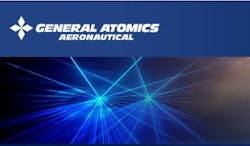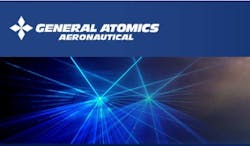Measurement team evaluates General Atomics Gen 3 high-energy laser
SAN DIEGO, 9 April 2015. An independent measurement team contracted by U.S. government officials completed beam quality and power evaluations of General Atomics Aeronautical Systems Inc.’s (GA‑ASI’s) Gen 3 High Energy Laser System (HEL) using the Joint Technology Office (JTO) Government Diagnostic System (GDS).
An independent measurement team employed the GDS to evaluate the beam quality of the Gen 3 system over a range of operating power and run time. According to JTO’s Jack Slater, “The system produced the best beam quality from a high energy laser that we have yet measured with the GDS. We were impressed to see that the beam quality remained constant with increasing output power and run-time.”
“These measurements confirm the exceptional beam quality of the Gen 3 HEL, the next-generation leader in electrically-pumped lasers,” explains Claudio Pereida, executive vice president, Mission Systems, GA-ASI, a manufacturer of remotely piloted aircraft (RPA) systems, radars, electro-optic and related mission systems solutions. RPA are also commonly known as unmanned aircraft systems (UAS), unmanned aerial vehicles (UAVs), and drones.
The new laser represents the third generation of technology originally developed under the High Energy Liquid Laser Area Defense System (HELLADS, Gen 1) program. The Gen 3 Laser employs a number of upgrades resulting in improved beam quality, increased electrical to optical efficiency, and reduced size and weight, officials say.
The certified Gen 3 laser assembly is compact, measuring only 1.3 x 0.4 x 0.5 meters. The system is powered by a compact Lithium-ion battery supply designed to demonstrate a deployable architecture for tactical platforms.
The Gen 3 HEL tested is a unit cell for the Tactical Laser Weapon Module (TLWM) currently under development. Featuring a flexible, deployable architecture, the TLWM is designed for use on land, sea, and airborne platforms and will be available in four versions at 50-, 75-, 150-, and 300-kilowatt laser output levels.
With run time limited only by the magazine depth of the battery system, beam quality was constant throughout the entire run at greater than 30 seconds. These measurements confirm that the exceptional beam quality of this new generation of electrically-pumped lasers is maintained above the 50 kilowatt level.
Following this evaluation, the independent team will use the GDS to conduct beam quality measurements of the GA-ASI HELLADS Demonstrator Laser Weapon System (DLWS). The HELLADS DLWS includes a 150-kilowatt class laser with integrated power and thermal management.
General Atomics Aeronautical Systems Inc., an affiliate of General Atomics, delivers situational awareness by providing remotely piloted aircraft systems, radar, and electro-optic and related mission systems solutions for military and commercial applications worldwide. The company’s Aircraft Systems business unit is a leading designer and manufacturer of proven, reliable RPA systems, including Predator A, Predator B/MQ-9 Reaper, Gray Eagle, new Predator C Avenger, and Predator XP. It also manufactures a variety of digital Ground Control Stations (GCS), including the next-generation Advanced Cockpit GCS, and provides pilot training and support services for RPA field operations. The Mission Systems business unit designs, manufactures, and integrates the Lynx Multi-mode Radar and sophisticated Claw sensor control and image analysis software into both manned and remotely piloted aircraft. It also focuses on providing integrated sensor payloads and software for intelligence, surveillance, and reconnaissance (ISR) aircraft platforms and develops high energy lasers, electro-optic sensors, and meta-material antennas.


